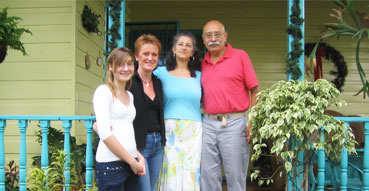About Escazú
One of San José’s greenest suburbs, Escazú is famous for its witches, stately homes, old adobe houses, astounding mountain and valley views, and much more.
San Rafael de Escazú, where Casa de las Tías is located, has restaurants, bars, discos and shops for every taste, a wonderful fruit stand, gas station, internet cafes, banks, ice cream parlors, and even a bagel shop! Just walk 6 blocks up the hill from Casa de las Tías and you will find yourself in downtown Escazú, a typical Latin American village with its church, central park, school and city hall.
Located only 9 kilometers/5 miles from the national capital city of San José, Escazú is a world apart. At an altitude of 1,100 meters/3,608 feet, its breezy climate, surrounding mountains, and picturesque colonial town set it apart from the urban bustle. Yet it is within minutes of upscale shopping centers, state-of-the-art hospitals such as CIMA (affiliated to Baylor University), and some of the best dental clinics, as well as art galleries and craft shops, with both traditional and contemporary offerings. Downtown San José is a 15-minute cab ride away, and the International Airport can be reached in 25 to 40 minutes, depending on the time of day.
Escazú's pre-Columbian origins are reflected in its name, which means "resting place." Its history is rooted in legends about a mountain-dwelling witch called Zárate; even today it is known as the “witch” capital of the country, with enduring stories of haunted houses, ghosts and even a magic monkey. A walk through the narrow streets of the main town brings visitors by well-preserved centuries-old adobe houses with oxcarts in the yards and clay-brick ovens still in use.
The most dramatic view of the area comes from the 2,000 meter/6,500 feet high cloud forest above San Antonio de Escazú, just 10 minutes by car from Casa de las Tías.
In the last decades the area has increasingly attracted an upscale population, becoming home to embassies, immigrants from North America, South America and Europe, and wealthy Costa Rican families. The Costa Rica Country Club is located in Escazú, and several horseback riding clubs as well as golf courses are a short distance away.
Yet Escazú's agricultural traditions live on, in its Saturday morning farmers' market, the organic farmers’ market, and its oxcart drivers or boyeros.
The now famous National Boyero Day takes place on the second Sunday of March with a parade of colorful hand-painted oxcarts, carrying families dressed in traditional costumes and pulled by teams of massive oxen often guided by five-foot, 12-year-old children. The parade ends in front of the Church of San Antonio de Escazú, with an array of traditional food and music. Casa de las Tías is a few blocks away from the parade route.
Escazú is also home to famous Costa Rican artists and artisans. Barry Biesanz’s Woodworks is well worth a visit to the hills of Escazú. This ecology-minded artist turns beautiful hard woods into exquisite bowls, boxes and furniture. Sculptor José Sancho, painter Cristina Fournier, jewelry designers Carmel Montoya and Sara Ulloa, Dutch artists Margreet Wielemaker-Postma, Ank Draijer, Ria Hauptkooper, and story teller Lola Pereira, among others, have made Escazú their home.
(for more on Escazú lore,
click here )


